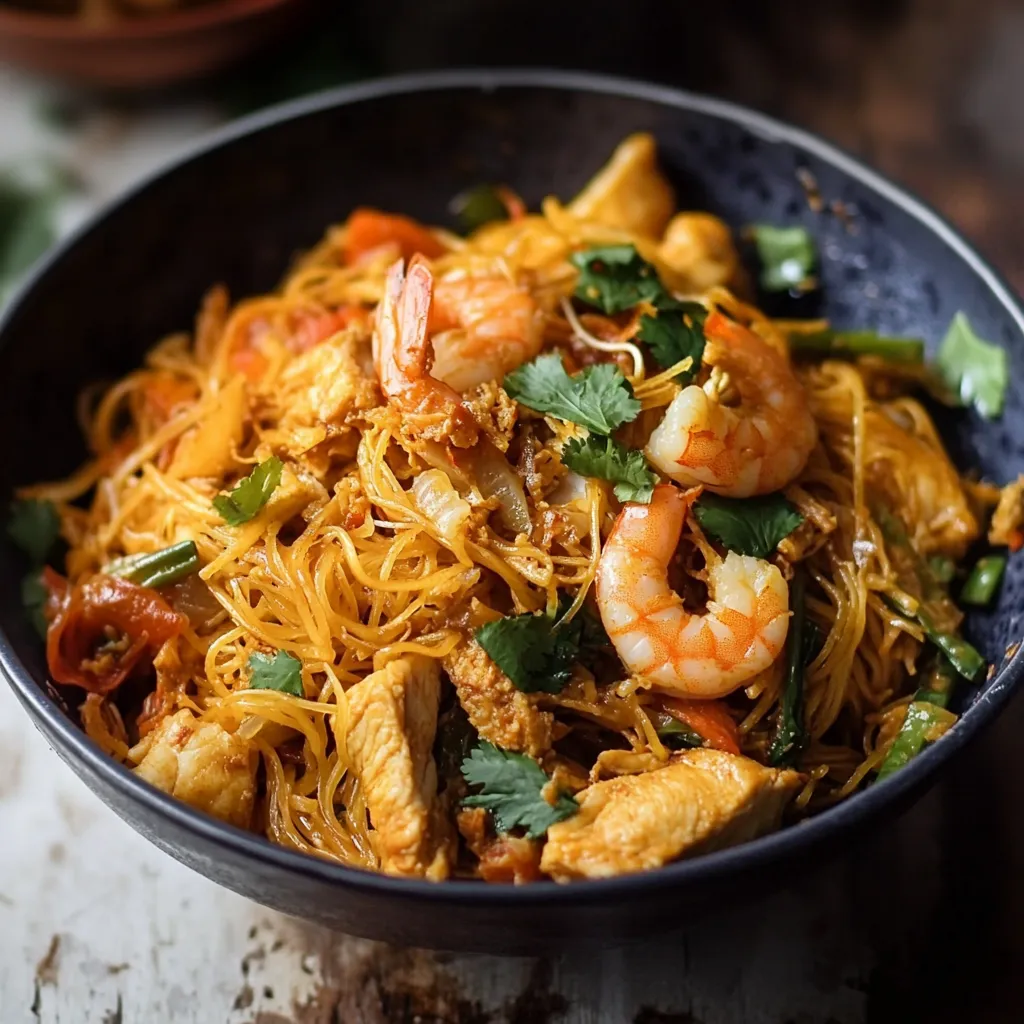 Save
Save
Singapore Street Noodles completely transformed my approach to homemade Asian cuisine. After discovering this recipe, it quickly became a household favorite that delivers restaurant-quality results with surprisingly little effort. The combination of curry-infused noodles, succulent proteins, and fresh vegetables creates an irresistible dish with layers of authentic flavor.
The real beauty of these noodles lies in their ability to rival any restaurant version while being remarkably straightforward to prepare at home. The fragrant curry sauce and perfectly cooked rice noodles create a dish that consistently impresses both family and guests.
Essential Ingredients
- Rice vermicelli: These delicate noodles form the foundation of the dish, absorbing the curry sauce beautifully. Rice sticks or thin rice noodles work equally well.
- Protein options: Traditional versions use both chicken and shrimp, though either works wonderfully on its own.
- Curry powder: The signature ingredient that provides both color and distinctive flavor.
- Asian sauces: A blend of soy sauce, mirin, and oyster sauce creates the perfect savory base.
- Vegetables: Bell peppers, carrots, and bean sprouts add essential crunch and color.
- Chili paste: Adds customizable heat to suit individual preferences.
 Save
Save
Essential Techniques
Preparation Is KeySuccessful execution relies heavily on mise en place - having all ingredients prepped and within reach before heating the wok. This organization ensures smooth cooking flow once heat hits the pan.
Protein PreparationPre-seasoning proteins with curry powder, white pepper, and paprika develops deeper flavor throughout the finished dish.
Wok HandlingConstant motion is crucial when stir-frying. High heat combined with continuous tossing develops authentic wok hei flavor.
Sequential CookingCook ingredients separately before combining at the end. This method ensures proper cooking of each component while preventing overcrowding in the wok.
The development of this recipe came from careful observation of traditional techniques combined with practical home cooking methods. Each component plays an essential role in creating the final harmonious dish.
Presentation
Serve as a complete meal or alongside Asian appetizers for a fuller spread. Garnish options like crushed peanuts, fresh herbs, citrus wedges, and chili allow customization. The dish maintains its quality when chilled, making excellent next-day meals.
Variations
Create a vegetarian version using crispy tofu, or try zucchini noodles for a low-carb alternative. Adding scrambled eggs creates silky ribbons throughout the dish for added richness and protein.
Storage
Refrigerate in airtight containers for up to three days. The flavors often intensify overnight. When reheating, add a small amount of liquid to refresh the texture.
 Save
Save
Technical Tips
- Monitor noodle soaking carefully to maintain ideal texture
- Use steam generation techniques for even cooking
- Finish with toasted sesame oil for aromatic depth
This versatile dish proves that authentic Asian flavors are achievable in home kitchens. With proper technique and quality ingredients, these noodles consistently deliver professional results.
Recipe FAQs
- → What type of noodles should I use?
- Traditional vermicelli noodles work great, but thin egg noodles are a good backup.
- → Can this recipe be made vegetarian?
- Absolutely! Just skip the shrimp and chicken, and try adding tofu or more veggies to replace them.
- → Do I need a wok to make it?
- No wok? No problem—you can use a large pan, although it may take a little longer to cook.
- → Will these noodles taste spicy?
- They’re mildly spicy. Want it hotter or milder? Just adjust how much chili paste or different curry powder you add.
- → Can I prep the ingredients ahead of time?
- Yep, go ahead and chop your veggies, mix the sauce, and prepare the proteins earlier to save time later.
Street-Style Noodles
A colorful combination of shrimp, chicken, fresh veggies, and rice noodles wrapped in an aromatic curry-based sauce.
Ingredients
→ Main Ingredients
→ Seasonings
→ Vegetables
→ Sauce
→ For Topping
Steps
Warm your wok over medium heat, adding 2 tablespoons of canola oil to coat.
In a saucepan, boil 3 cups of salted water. Cook noodles for a quick 3 minutes, then drain and rinse under cool running water. Toss them with sesame oil and set aside for later.
Split the chicken and shrimp into different bowls. Mix white pepper, curry powder, paprika, and salt in a small dish. Sprinkle the seasoning mix evenly on the chicken and shrimp, dividing it between them.
Put the chicken into the heated wok and stir-fry it for about 5 minutes. Toss in the shrimp and garlic, cooking for 3 more minutes until both are done. Remove them from the wok, but leave the wok as is.
Drop 1 more tablespoon of canola oil into the empty wok. Add the prepared vegetables and stir-fry for roughly 5 minutes, letting them soften.
Toss the noodles, chicken, and shrimp back into the wok. Stir everything gently, then add the sauce and make sure it coats everything nicely. Let it simmer for a few minutes before sprinkling on fried shallots and fresh cilantro.
Notes
- A wok works best since it cooks food evenly.
- Get your ingredients ready beforehand for a smoother cooking process.
- Bright-colored vegetables make this dish pop visually.
Required Tools
- Wok or large pan
- Strainer or colander
- Bowls for mixing
- A pot for boiling water
Allergy Information
Check each ingredient for potential allergens and consult a healthcare professional if needed.
- Includes shrimp (shellfish)
- Made with soy products
- Contains oyster sauce (fish)
Nutritional Facts (per serving)
These details are provided for informational purposes and aren't a substitute for medical advice.
- Calories: 460
- Fats: 9 g
- Carbohydrates: 75 g
- Proteins: 18 g
